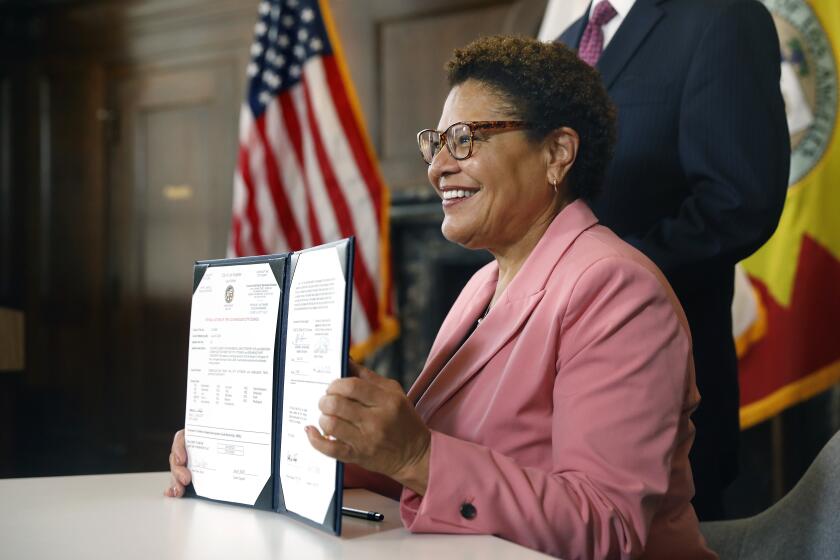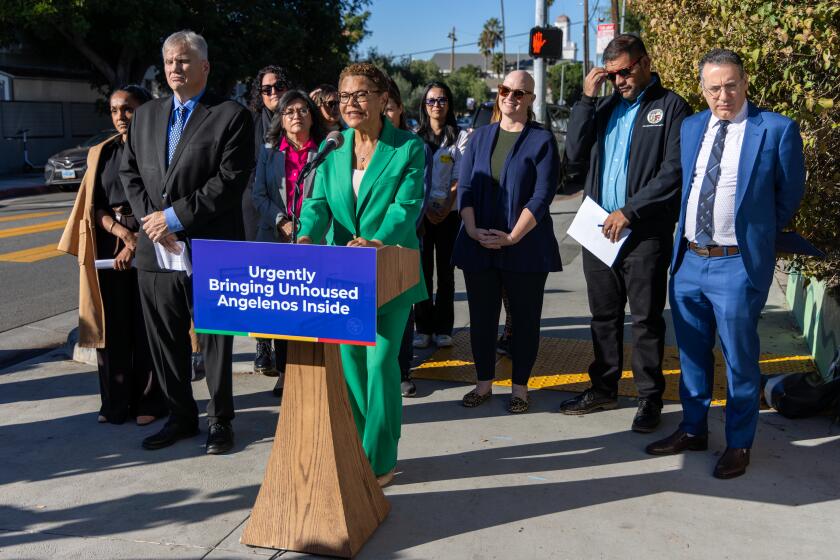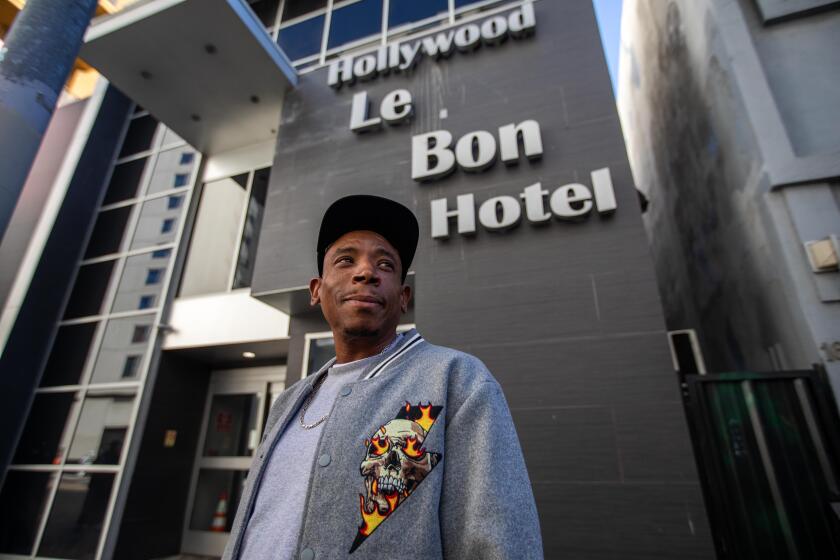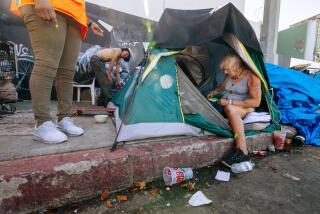Editorial: Bass had a strong first year on homelessness. Year 2, L.A. needs more housing
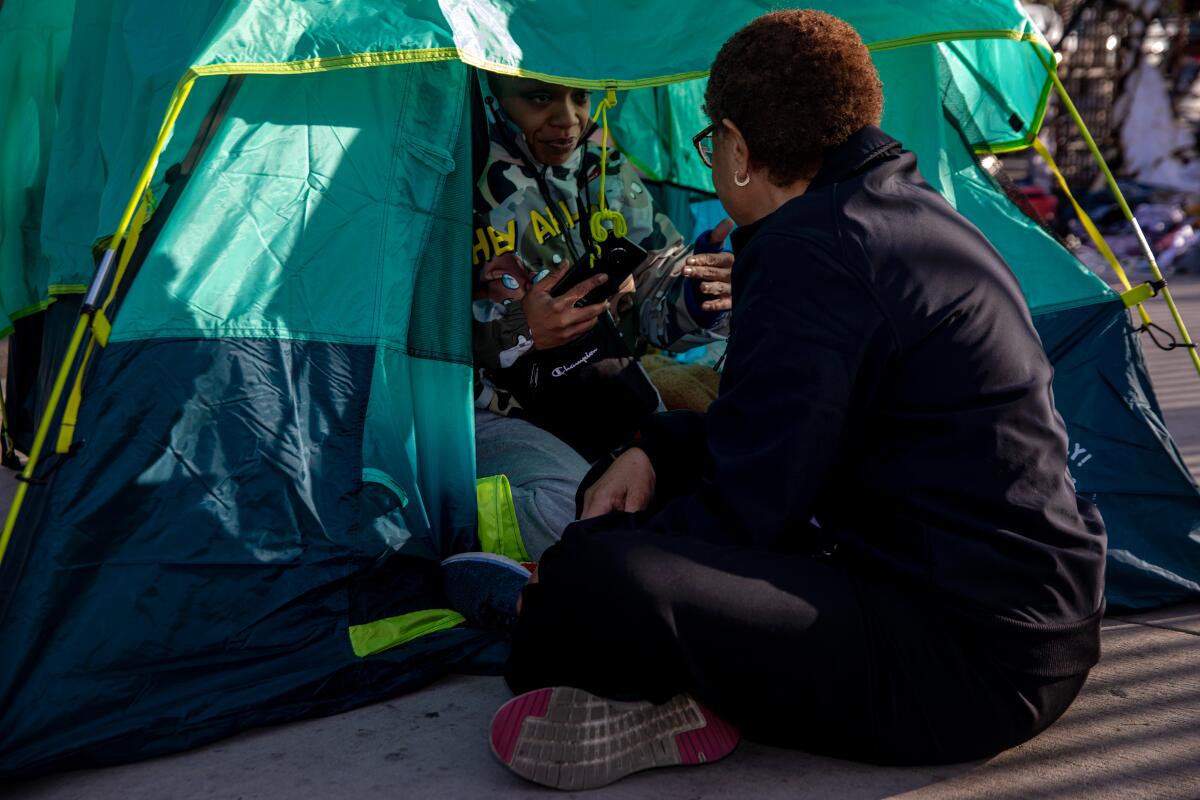
- Share via
There is no problem more fraught and seemingly intractable in Los Angeles than homelessness. Karen Bass knew that when she came into office last December — a month before the annual count found that homeless numbers in the city had gone up 10% to 46,260.
As mayor, Bass has made homelessness her unwavering primary focus, not just proclaiming it an urgent matter but addressing it with specific plans. She has quickly learned the issues surrounding homelessness and begun to tackle them. She’s had a very good start.
Executive Directive 1 turned on the tap for construction of new, and desperately needed affordable housing. The City Council should make it permanent.
After signing an emergency declaration on homelessness, she issued Executive Directive 1, which fast-tracks land-use approval, permitting and inspections for developers of 100% affordable housing. As of October, that resulted in at least 9,000 units of affordable housing either approved or expected to be approved. She also created the Inside Safe initiative, her signature program that moved 1,951 people out of street encampments and into motel and hotel rooms around the city in the last 12 months.
And Bass is right to say that Inside Safe counters the often-repeated canard that homeless people would rather be on the street than inside. In fact, if people are offered something they want — such as a motel room with a door that locks and its own bathroom — they will take it.
Venice Dell will provide much-needed homeless and affordable housing. So why isn’t Mayor Karen Bass championing this project, instead of allowing more delays?
Overall, she has accelerated the pace of building desperately needed affordable housing and getting people at least temporarily housed. She says she has moved 21,694 people into temporary housing, many into tiny homes and various types of group shelters, not hotel or motel rooms. Not everyone stayed. Of the 1,951 people placed into housing through Inside Safe, 81% remain in the program. The retention rate for the other 19,743 people was 64%. Most of the 7,107 people who left have no contact with service providers and their whereabouts are unknown.
We do know that through Inside Safe, 256 people moved into permanent housing. That’s a pretty modest number.
However, the mayor’s office says that 7,717 people were able to use housing vouchers to get an apartment — that’s 2,500 more than in 2022. And 3,551 people moved into subsidized permanent units. All these numbers overlap to a certain extent, according to Los Angeles Homeless Services Authority officials. So it’s hard to get a precise picture of progress.
Mayor Karen Bass talks about the thousands she’s moved into interim housing. But it’s the removal of encampments that will make Angelenos believe it.
To get to these numbers of people permanently housed, Bass had some help from resources newly available to the city.
A total of 2,005 units of permanent supportive housing were subsidized by the city’s Proposition HHH bond measure that became available this year, according to the L.A. Housing Department. (That is in addition to the 1,940 HHH units already open.) And the city will have collected roughly $150 million in revenue from Measure ULA (United to House L.A.), the real estate transfer tax passed by voters in 2022.
The measure is still being fought over in court, but Bass is wisely using those funds anyway to help finance much-needed rental subsidies, an eviction defense program and affordable housing projects. Bass said federal reimbursement money owed to the city could cover whatever funds might need to be returned if the tax is overturned in court.
All in all, Bass has moved at an impressively fast pace to get homeless people off the streets and fast-track affordable housing.
As her Inside Safe program enters its second year, Bass said she is determined to clear the bottleneck keeping homeless residents from getting into permanent homes.
Which is why it’s confounding that she and her city departments have not moved as quickly as they could in pushing forward a large project in Venice that would provide 140 units of housing for homeless and low-income individuals. The Venice Dell Community project is one of few supportive housing projects on the Westside. It has been approved twice by the City Council and is waiting for the approval of the state Coastal Commission — which can’t proceed until the city finishes and submits paperwork on behalf of the project.
Asked about the project, Bass said city departments are working on it, adding, “I do believe the Venice Dell project is going to get built.” Good, because if ever there were a project that needed and deserved some fast-tracking, it’s this one.
As she enters her second year in office, Bass should pay close attention to whether homelessness prevention efforts are keeping people from falling into homelessness. She’s aware that a rise in evictions could go hand in hand with a rise in homelessness. That may be an area for her to tackle.
She has emphasized how quickly she wants to move homeless people inside into temporary housing and calls the option to leave them on the street until permanent housing is available “intolerable.”
That’s why permanent housing is exactly what she should be prioritizing in 2024. Renting motels and hotels is exorbitantly expensive. (She has $250 million from the City Council to use for this.) She wants to master lease motels and hotels for extended periods to get lower rates and have the properties longer.
Of course, this doesn’t mean the city should stop renting motels and hotels. Bass says she’s sensitive to the concerns of residents who complain when new encampments appear on streets that got cleared through Inside Safe. She says she tells them that service providers will come back out again and move homeless people into motels and hotels.
But there are only so many hotels and motels the city can afford to rent as interim housing. As it is, people are not moving quickly out of motels and hotels into permanent housing. Some stay a year or longer waiting for permanent housing, service providers say.
As more people get in line for permanent housing, the city will have a bottleneck of people staying in hotels leaving others stuck camping on the street. The only solution is to create more permanent housing faster.
